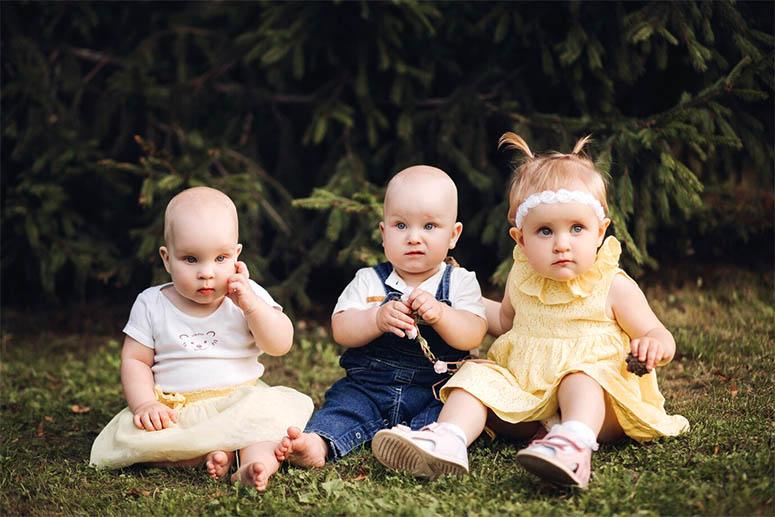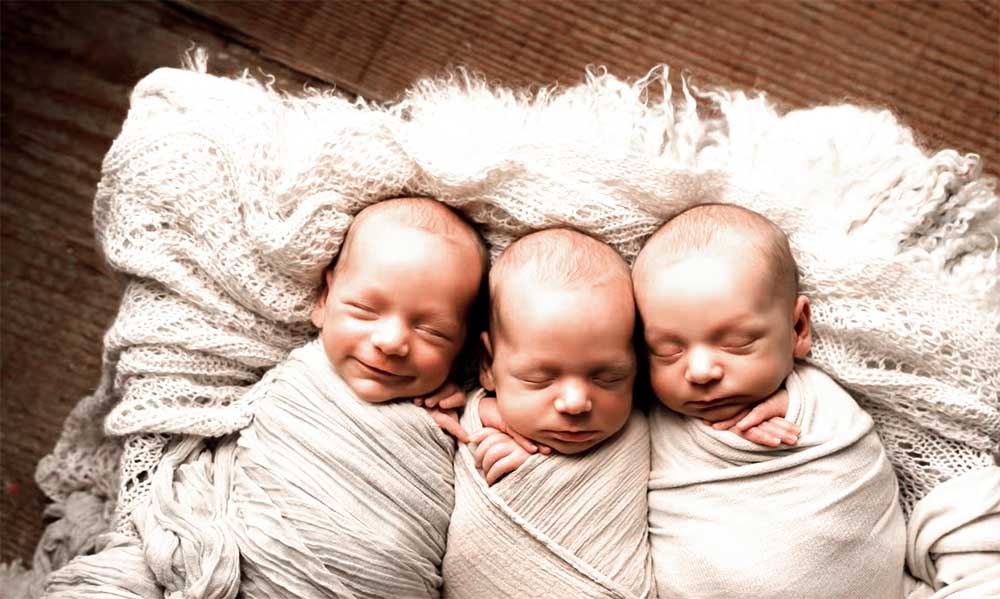Contents
What are the odds of having triplets and the possibility of it is a really fascinating topic that draws attention for its rarity and the unique challenges it presents.
Let’s delve into the factors influencing the chances of conceiving triplets, narrowing down the probabilities step by step and find the answer of the question – What are the odds of having triplets?.
What are the odds of having triplets – the natural baseline
When considering what are the odds of naturally conceiving triplets, the baseline probability is quite low. The natural occurrence of triplets without the aid of fertility treatments is rare, with the chances averaging about 1 in 8,100 pregnancies.
This figure serves as our starting point for examining how various factors influence these odds. The baseline odds of having triplets are primarily determined by random genetic and biological factors.
From this baseline, we can analyze how additional variables such as family history, maternal age, and fertility treatments can increase the likelihood.
Understanding these odds is crucial for those curious about or planning for multiple births, as it provides a foundation for further exploration into specific influencing factors. As we delve deeper into these factors, it becomes evident how they cumulatively affect the overall odds of conceiving triplets, highlighting the complexity and rarity of such pregnancies.
Genetic factors affecting the chances of having triplets
Genetic factors play a significant role in determining the likelihood of having multiples, including triplets. These factors can be broken down into family history and ethnicity, each contributing differently to the probability of multiple births.
Family history
A family history of multiple births, particularly on the mother’s side, can substantially increase the odds of conceiving multiples. This genetic predisposition is often linked to hyperovulation, where the ovaries release more than one egg during a menstrual cycle.
Women who inherit genes that cause hyperovulation are more likely to conceive twins or triplets. The exact increase in odds varies, but studies suggest that if a woman has a mother or sister who had multiples, her chances of having twins can be about 1 in 60.
For triplets, while exact figures are harder to pinpoint due to the rarity, the presence of multiples in the family can be a crucial indicator, potentially increasing the odds to about 1 in 500.
What are the odds of having triplets according to the ethnicity

Ethnicity is another significant factor affecting the likelihood of multiple births. The incidence of twins and higher-order multiples varies across different ethnic groups. African women have the highest rates of multiple births globally. So what are the odds of having triplets? For example, Yoruba women in Nigeria have an exceptionally high twin birth rate of about 45 twins per 1,000 births.
This is significantly higher than the rate among Caucasian women, which is approximately 9 to 16 twins per 1,000 births, and much higher than among Asian women, where the rate is around 6 to 9 twins per 1,000 births. These differences are believed to be due to genetic variations that affect ovulation rates.
For triplets, while specific ethnic statistics are less well-documented, the trend follows that populations with higher rates of twin births also tend to have higher rates of triplet births. Therefore, African women would again have a relatively higher likelihood of having triplets compared to their Caucasian and Asian counterparts.
Maternal age as a factor for having triplets
Maternal age is a significant factor influencing the likelihood of conceiving triplets. Women in their 30s, particularly those between 35 and 40, are statistically more likely to release multiple eggs during ovulation compared to younger women. This increased likelihood is primarily due to elevated levels of follicle-stimulating hormone (FSH) as women age. FSH is responsible for stimulating the ovarian follicles to mature and release eggs.
As women approach their mid to late 30s, their bodies may respond to declining egg quality and quantity by producing more FSH, which can lead to the simultaneous maturation and release of multiple eggs.
Research shows that the chances of conceiving multiples, including triplets, rise with maternal age up to a point. For instance, the probability of having twins naturally increases from about 1 in 100 for women under 25 to about 1 in 60 for women aged 35 to 39. While specific statistics for triplets are harder to pin down, the pattern follows a similar trend, albeit at much lower baseline rates.
The data underscores that while older maternal age can increase the chances of multiple ovulations, it also comes with increased risks, including potential complications during pregnancy and childbirth. Thus, while age can enhance the probability of triplets, it is crucial to balance these odds with careful medical supervision and planning.
What are the odds of having triplets with fertility treatments
Fertility treatments have a profound effect on the chances of conceiving triplets, significantly increasing the odds compared to natural conception.
In Vitro fertilization (IVF)
When we discuss the topic ‘What are the odds of having triplets,’ there is no chance that we wouldn’t mention IVF.
IVF involves retrieving eggs from a woman’s ovaries, fertilizing them with sperm in a lab, and then transferring the resulting embryos to the uterus. The number of embryos transferred greatly influences the likelihood of multiple births.
According to the Centers for Disease Control and Prevention (CDC), transferring two embryos results in twins about 12% of the time, while transferring three or more embryos can result in triplets or higher-order multiples.
The specific odds of having triplets via IVF can range from 1 in 100 to 1 in 30, depending on the number of embryos transferred and their quality. This is a substantial increase from the natural baseline odds of 1 in 8,100 pregnancies.
Ovulation-Stimulating medications
Medications such as Clomid (clomiphene citrate) and gonadotropins (FSH and LH) are designed to stimulate the ovaries to produce multiple eggs during a single ovulation cycle. Clomid is often the first line of treatment for women experiencing ovulation issues.
Studies have shown that Clomid increases the chances of twins to about 7-9%, with the likelihood of triplets being approximately 0.5%. Gonadotropins, on the other hand, are more potent and carry a higher risk of multiple births.
The chance of triplets with gonadotropins can be as high as 1 in 20 pregnancies, reflecting a significant increase from natural conception.
These treatments, while effective in addressing fertility issues, require careful monitoring to manage the risk of high-order multiples, ensuring the health and safety of both the mother and the babies.
Lifestyle and other factors
When considering the question “What are the odds of having triplets?” lifestyle and other factors play a crucial role. Among these, diet, nutrition, and previous pregnancies significantly influence the likelihood of conceiving triplets.
Diet and nutrition
Some studies suggest a link between diet and the answer to the question, ‘What are the odds of having triplets?’
One interesting observation is that women who consume dairy products regularly might have a higher chance of conceiving multiples.
This correlation is attributed to insulin-like growth factor (IGF), a protein found in higher concentrations in the blood of individuals who consume dairy. IGF enhances ovarian function and can increase the likelihood of releasing multiple eggs during ovulation.
Moreover, women with a higher body mass index (BMI) are statistically more likely to conceive multiples. A higher BMI is associated with elevated levels of estrogen, which can stimulate the ovaries to release more than one egg per cycle. However, it’s important to note that a higher BMI also comes with its own health risks, and the benefits and risks should be balanced carefully.
Previous pregnancies
A woman’s obstetric history can also affect the answer of the question”What are the odds of having triplets”.
Women who have had multiple pregnancies, especially those with a history of multiples, are more likely to conceive multiples again.
This pattern is partly due to the physiological changes and adaptations in the body that occur with each pregnancy, which might make it more conducive to releasing multiple eggs in subsequent ovulation cycles.
For instance, a woman who has already given birth to twins has a higher probability of conceiving multiples again compared to a woman with no history of multiples. This increased likelihood can be attributed to both genetic and physiological factors that favor multiple ovulations.
Other lifestyle factors
Beyond obstetric history, various lifestyle factors can impact the odds of having triplets:
- Fertility Treatments – The use of fertility treatments, such as in vitro fertilization (IVF) and ovulation-inducing medications, significantly increases the chances of multiple births.These treatments often involve stimulating the ovaries to produce multiple eggs, which can result in the fertilization of more than one egg and the subsequent development of triplets.
- Diet and Nutrition – Certain dietary factors may influence fertility and the likelihood of multiple births. For example, some studies suggest that women who consume dairy products or have a higher intake of certain nutrients might be more prone to conceiving multiples.
- Age – Maternal age can also play a role. Women over 30, particularly those in their late 30s, have higher levels of follicle-stimulating hormone (FSH), which can lead to the release of multiple eggs during ovulation. This increase in FSH levels can raise the likelihood of conceiving triplets.
- Geographic and Ethnic Factors – Geographic location and ethnic background can naturally affect the rates of multiple births. For example, women of African descent are statistically more likely to have multiple births compared to women of Asian descent, who have the lowest rates of multiples. Additionally, certain regions have higher incidences of multiple births, although the reasons for this can vary and include both genetic and environmental factors.
How rare are identical triplets?

Identical triplets are a rare phenomenon that fascinates both the medical community and the general public.
If the answer to ‘What are the odds of having triplets?’ seems difficult to determine in terms of probability, then the answer to the even more complex question, ‘What are the odds of having identical triplets?’ is even more challenging.
Unlike fraternal triplets, where each baby develops from a separate egg fertilized by a separate sperm, identical triplets occur when a single fertilized egg splits into three genetically identical embryos. This rarity adds an extra layer of wonder to the already intriguing subject of multiple births.
The odds of having identical triplets are extremely low, estimated at about 1 in 200,000 births.
This rarity is due to the complex and somewhat random nature of an embryo’s division.
For identical triplets to occur, the fertilized egg must not only split once (which would result in identical twins), but one of those resulting embryos must then split again, all within a very narrow window of early development.
The exact timing and mechanism behind these splits are not entirely understood, and factors influencing this phenomenon are still a subject of ongoing research.
Identical triplets are considered even rarer than other forms of triplets due to the precise conditions required for their formation. Additionally, the survival rates and health outcomes for identical triplets can vary and are subject to several risks associated with high-order multiple pregnancies. These risks include preterm birth, which is almost a certainty with triplets, and the potential for significant medical complications for both the mother and the infants.
Medical advancements, however, have improved outcomes significantly. Prenatal care, including frequent monitoring and the use of advanced imaging technologies, helps manage the unique challenges of triplet pregnancies. Such care is crucial for identifying and mitigating risks early in the pregnancy.
Despite these challenges, the birth of identical triplets is often celebrated as a remarkable event. For families and medical professionals alike, the arrival of identical triplets is not just a medical rarity but a miraculous occurrence.
It’s a reminder of the complexities and mysteries of human reproduction, highlighting the extraordinary processes that sometimes occur in what begins as a routine pregnancy.
Understanding the odds of having triplets requires a comprehensive look at various factors, including lifestyle and physiological aspects. While diet, BMI, and previous pregnancies are significant influencers, it’s essential to consider the holistic picture, including genetics and medical history. Balancing these factors can help in understanding and potentially influencing the likelihood of conceiving triplets, answering the intriguing question of “What are the odds of having triplets?“



